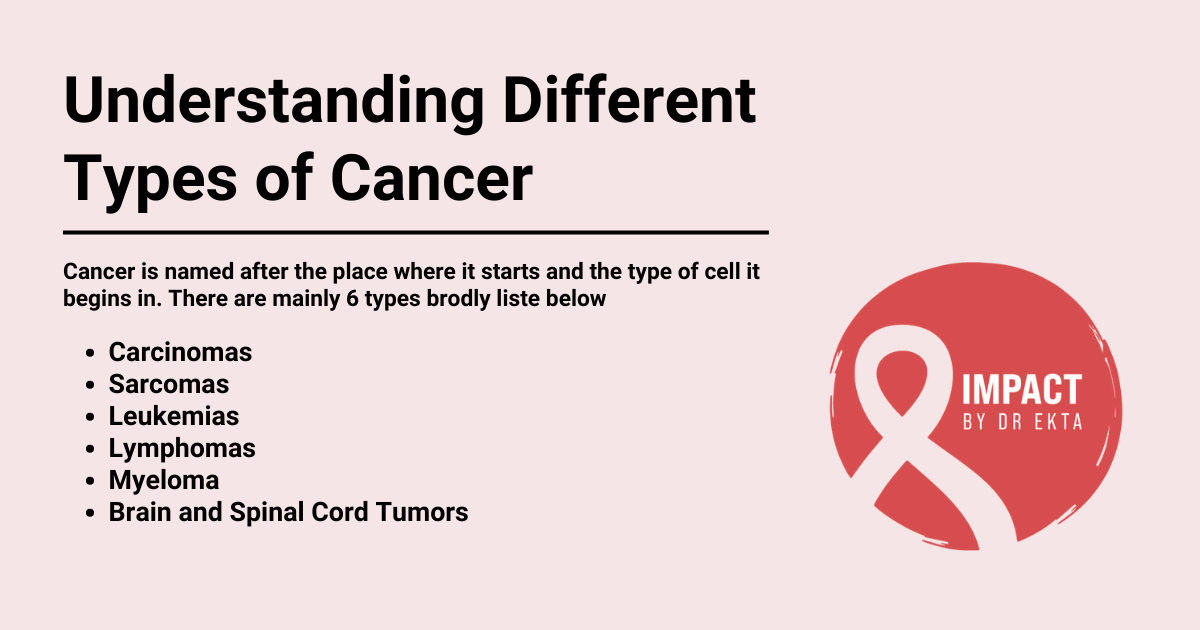Understanding Different Types of Cancer: A Guide for Everyone
Namaste, I’m Dr. Ekta Vala Chandarana. Cancer is named after the place where it starts and the type of cell it begins in. In this page we try to understand different types of cancer. Here are the main types:
Main Types of Cancers

Types of Cancer: #1 Carcinoma
Carcinoma represents the most prevalent form of cancer, originating in the epithelial tissues that play a crucial role in covering the body’s exterior and interior linings. These cancers manifest in various forms, primarily affecting the skin, internal organ linings, and body cavities. Within the broad category of carcinomas, there are several subtypes, each with unique characteristics and origins.
Understanding Carcinoma and Its Subtypes
Epithelial tissues, where carcinomas develop, serve multiple functions:
- They form the skin’s outer layer, offering protection.
- They line the interiors of organs and body systems, including the digestive tract.
- They cover the internal spaces of the body, such as the chest and abdominal cavities.
Given their widespread presence across the body, it’s not surprising that carcinomas include a significant number of cancer cases, such as those affecting the breasts, lungs, colon, skin and prostate.
Diving Deeper into Carcinoma Subtypes
The specific type of epithelial cell affected by cancer determines the subtype of carcinoma. These include:
Squamous Cell Carcinoma: Originates in the flat, surface cells present in the skin or the lining of some organs, like the throat or esophagus.
Adenocarcinoma: Begins in glandular cells known as adenomatous cells, which are responsible for fluid production that keeps tissues moist.
Transitional Cell Carcinoma: Arises from cells capable of stretching with organ expansion, found in tissues like the bladder’s lining.
Basal Cell Carcinoma: Develops in the basal cells situated in the skin’s deepest layer.
Types of Cancer: #2 Sarcomas
Sarcomas represent a unique and less common category of cancer that originates in the body’s connective tissues. These tissues are crucial for providing support and structure to various parts of the body, including bones, cartilage, tendons, and the fibrous tissues surrounding organs.
Diving Into Sarcomas
Though sarcomas are rarer compared to carcinomas, they are significant for their origin in the connective tissues, falling into two primary categories:
Bone Sarcomas: These cancers begin in the cells that form bones, embodying a distinct group within the sarcoma family.
Soft Tissue Sarcomas: While less common, these sarcomas start in non-bony connective tissues, such as cartilage or muscle, making up a small fraction of cancer diagnoses annually.
Despite their rarity, sarcomas are important to recognize and understand due to their potential impact on the body’s structural system.
Specific Types of Sarcomas
Sarcomas of the bone and soft tissues present in various forms, with some of the more common types including:
Bone Sarcomas: Originating directly from bone cells, these sarcomas affect the skeletal system.
Soft Tissue Sarcomas: Among these, the notable types are:
- Chondrosarcoma: This cancer arises in cartilage, the rubbery tissue padding bones at joints.
- Rhabdomyosarcoma and Leiomyosarcoma: These cancers develop from muscle cells, with rhabdomyosarcoma starting in skeletal muscle and leiomyosarcoma originating in smooth muscle found in organs.
Types of Cancer: #3 Leukaemias - Blood Cancer
Leukemias, often referred to as blood cancer, represent a distinct group within the diverse spectrum of cancers, characterized by an overproduction of white blood cells in the bone marrow. Unlike other cancer types that form tumors, leukemias directly affect the blood and the bone marrow, leading to a proliferation of immature or abnormal white blood cells that impair the body’s ability to fight infections effectively.
Understanding Leukemias (Blood Cancer)
Leukemias account for a small fraction of all cancer diagnoses, representing approximately 3% of cancer cases globally. Despite their overall rarity, leukemias are notably the most prevalent form of cancer among children, highlighting the importance of understanding this type of cancer for both patients and healthcare providers.
How Leukemias (Blood Cancer) Develop
In leukemia, the bone marrow begins to produce white blood cells at an abnormal rate. These cells often lack full development and functionality, failing to perform their normal role in combating infections. As these abnormal cells accumulate, they can crowd out healthy blood cells, leading to serious health issues, including anemia, infection, and bleeding disorders.
Types of Leukemias (Blood Cancer)
Leukemias can be classified based on the speed of progression and the type of white blood cell affected. The main types include:
Acute Leukemias: These progress rapidly and require immediate treatment. They are characterized by the swift accumulation of immature blood cells in the bone marrow and blood.
Chronic Leukemias: Progressing more slowly, chronic leukemias involve more mature, but still abnormal, blood cells. These types of leukemia often manifest with subtle symptoms over a longer period.
Types of Cancer: #4 Lymphomas
Lymphomas represent a specific category within the broad spectrum of cancers, distinguished by their origin in the lymphatic system. This system is an integral part of the body’s immune defense, comprising lymph nodes, the spleen, thymus, and bone marrow. Lymphomas involve the abnormal proliferation of lymphocytes, a type of white blood cell vital for fighting infection.
Types of Lymphomas
Lymphomas are categorized into two main types, each with distinct characteristics and treatment approaches:
Hodgkin’s Lymphoma (HL): Characterized by the presence of Reed-Sternberg cells, a specific type of abnormal cell, Hodgkin’s Lymphoma is notable for its predictable progression from one lymph node group to another. Its diagnosis often involves a biopsy to identify these unique cells.
Non-Hodgkin’s Lymphoma (NHL): This diverse group of lymphomas is not defined by Reed-Sternberg cells and can occur in any part of the lymphatic system. Non-Hodgkin’s Lymphoma encompasses a wide range of subtypes, varying significantly in their severity and speed of progression.
Types of Cancer: #5 Myeloma
Myeloma, also known as multiple myeloma, is a type of cancer that specifically targets the plasma cells in the bone marrow. Plasma cells are a kind of white blood cell crucial for producing antibodies that help fight infection. However, in myeloma, these cells become cancerous and multiply excessively, disrupting the normal production of blood cells and leading to a range of health issues.
Understanding Myeloma
Unlike other cancers that form solid tumors, myeloma is characterized by the proliferation of malignant plasma cells in the bone marrow. This can lead to anemia, bone pain and fractures, kidney dysfunction, and a weakened immune system due to the reduction of healthy blood cells.
Myeloma accounts for about 1% of all cancers and is considered a rare disease. It predominantly affects older adults, with most diagnoses occurring in individuals over the age of 60. Despite its rarity, myeloma poses significant challenges due to its chronic nature and the complexities involved in its management and treatment.
Types of Cancer: #6 Brain Tumors and Spinal Cord Tumors
Cancers originating in the brain or spinal cord are critical types within the broader spectrum of cancers, deeply affecting the central nervous system. The central nervous system, a complex network that controls various bodily functions, consists of the brain and the spinal cord. The brain, the control center of the body, sends and receives messages via nerve fibers. These fibers extend out of the brain to form the spinal cord, which also channels messages between the body and the brain.
Understanding Brain Cancer and Spinal Cord Cancer
The brain houses billions of nerve cells, known as neurons, and is supported by specialized connective tissue cells called glial cells. The most prevalent form of brain tumor, glioma, arises from these glial cells. Tumors in the brain or spinal cord can vary widely in their behavior; while some remain non-cancerous (benign) and grow slowly, others are cancerous (malignant) and exhibit rapid growth and spread.
In India, as well as globally, brain and spinal cord tumors account for a small percentage of all cancer diagnoses, yet their impact is profound due to the critical functions of the affected areas.
Types of Brain Tumors and Spinal Cord Tumors
Gliomas: The most common category of brain tumor, originating from glial cells. Gliomas themselves are categorized based on the specific type of glial cell involved.
Benign Tumors: These tumors grow slowly and do not spread to other parts of the body. However, their location in the brain or spinal cord can still lead to significant health issues.
Malignant Tumors: Characterized by their aggressive growth and potential to invade nearby tissues. These tumors pose a significant challenge due to their impact on the central nervous system’s functions.
